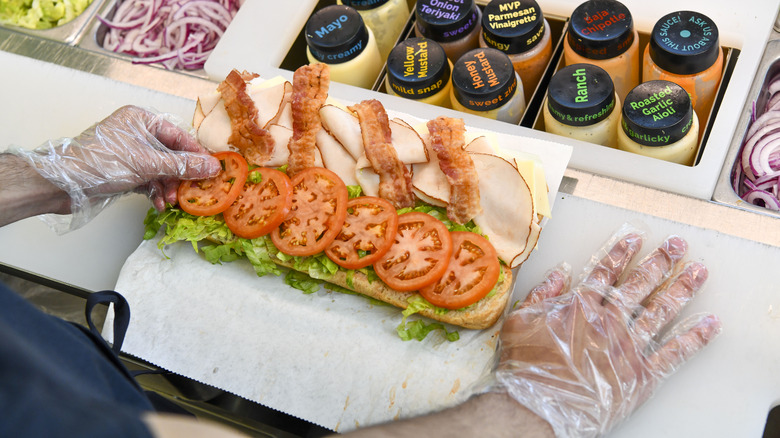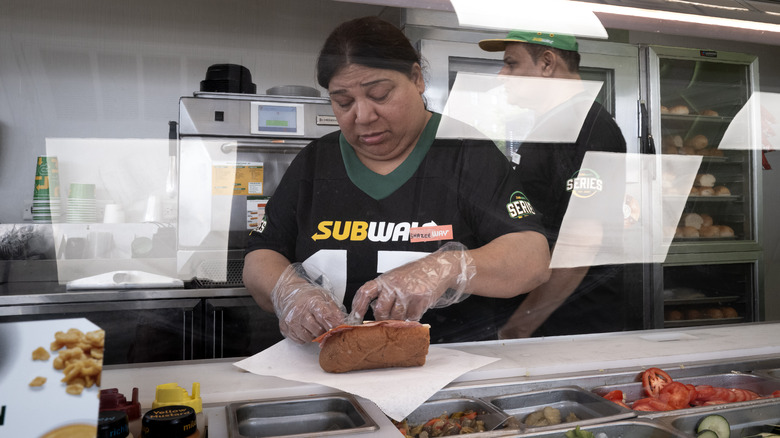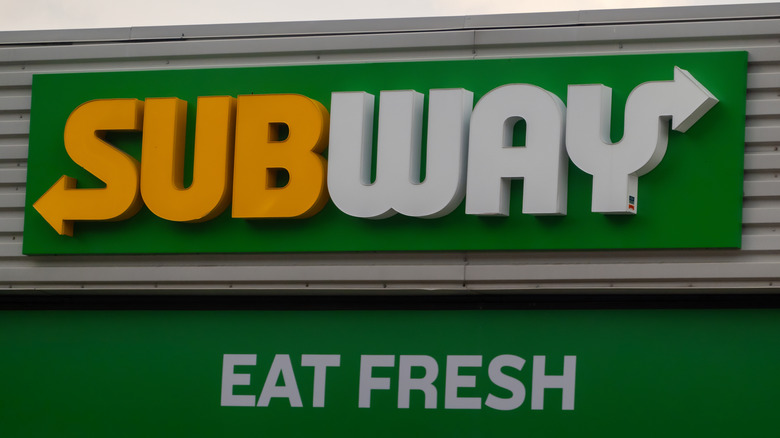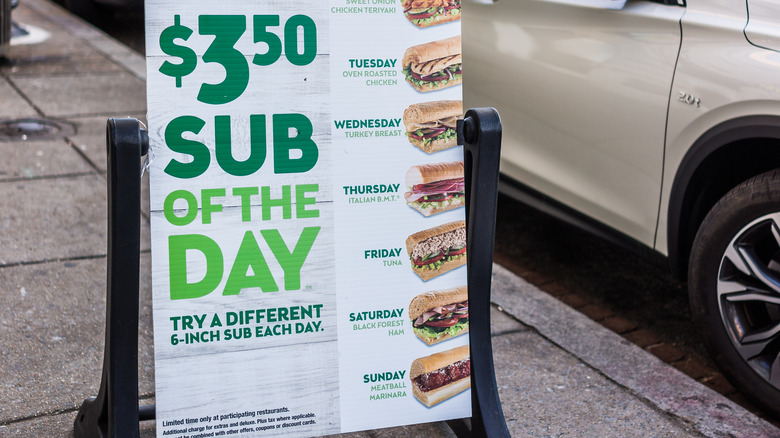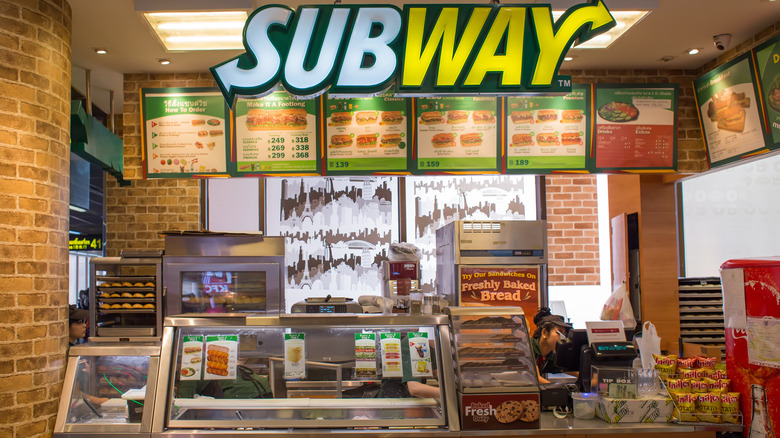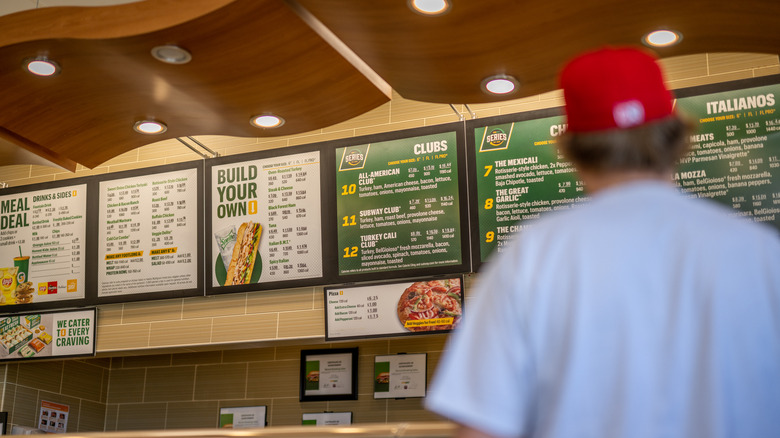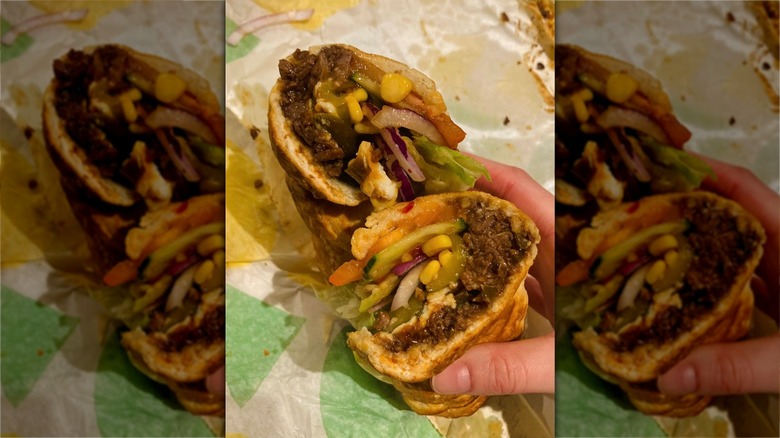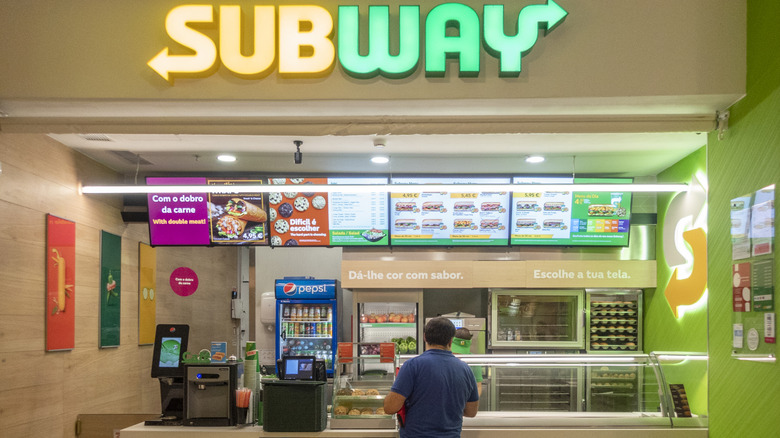10 Reasons This Popular Sandwich Chain Is No Longer America's Favorite
Subway used to be a leading player in fast food, but has lost a lot of ground over the last decade. The chain — known for its custom-made subs and "Eat Fresh" slogan – is now struggling to keep pace with what consumers want and where food trends are going. Once the world's largest fast-food chain by store count, Subway has lost more than 7,000 stores since 2015 and continues to fall short compared to its fresher, more modern rivals. Central to its falloff is a menu that hasn't changed quickly enough — or maybe just not meaningfully enough — to keep up with changing tastes.
Efforts to revamp the menu have not proven particularly successful. Health-conscious diners have also begun to question the chain's image as a healthy option, as studies and nutritional breakdowns show high levels of sodium, the downsides of eating an excess of processed meats, and controversial ingredient sourcing. Subway may have a holiday cookie big enough to stuff a stocking, but a series of scandals, a boom in underperforming franchise locations, and higher prices have only served to further tarnish its image over the years. Let's break down some of the reasons this once beloved chain is no longer America's sandwich go-to.
Fan favorite breads have disappeared
One of the quieter shifts that irked long-time Subway fans was the gradual fading of a few favorite bread choices. Over the past few years, regulars have noticed that the classic Hearty Italian Bread and Jalapeño Cheddar Bread are missing from their stores. While Subway didn't officially declare their discontinuation, employees online have confirmed that a few breads have quietly been retired from their stores or are no longer on the delivery trucks.
At first glance, the vanishing of a few breads feels small, yet bread has always defined Subway. Unlike many other fast food chains, where the bread plays a background role, Subway's loaves are the canvas on which the brand is painted. The fact that customers were able to pick from an array of hot, crusty choices set Subway apart when it was beginning to peak in the market. Losing the beloved breads in some locations has left many questioning if they want to continue dining at the chain. The fallout is bigger than pickiness. When the breads that first welcome a meatball, a veggie, a splash of red sauce start slipping away, it's easy for a diner's mind to picture tighter budgets or a brand that has lost its grip.
Competitors are winning
Subway's competitors in the sandwich industry are making it harder and harder to stay on top. For example, Jersey Mike's, which was acquired by Blackstone for $8 billion in 2024, has built a loyal customer base with its signature approach of slicing meats and cheeses fresh at the counter. Meanwhile, Firehouse Subs uses its firefighter-themed narrative to promote its hearty hot sandwiches, and Jimmy John's maintains its focus on quick service and basic menu options while using a fun company personality to appeal to younger customers.
In short, Subway's rivals have very clearly defined identities compared to Subway. It also doesn't hurt that customers have lavished praise upon the sandwiches found at rival chains while comparing them to those sold at Subway. The customization model that once served as Subway's main advantage now feels outdated when compared to the streamlined presentation and carefully crafted menus of its competitors.
This feels evident in the way the market is responding. According to CNN, Subway closed over 600 stores in 2024 alone, with its total number of locations in the U.S. dropping to less than 20,000 for the first time in two decades. Meanwhile, Subway's sandwich shop competitors are growing, with Jersey Mike's, Jimmy Johns, and Firehouse Subs all sharing ambitious expansion plans. It feels like Subway's image is still stuck in the 2000s, lacking the clarity and innovation needed to compete with these other modern players who understand exactly what today's sandwich lover wants.
Failed value meals reflect weak demand
In an effort to win back customers and boost sales, Subway introduced a value meal promotion in 2024 that offered a 6-inch sub with a drink and your choice of chips or two cookies for $6.99. At first, the strategy looked solid. After all, discount lovers usually outnumber discount skeptics. But the reception was weak, and the promotion was quietly shelved after a few weeks, with sales and traffic reportedly falling short of Subway's projections.
Its price alone wasn't the problem. Today's customers don't necessarily just view value as a number. Instead, they're looking for food that feels fresh, flavorful, and wholesome. A lower price is irrelevant if the product doesn't elevate the experience above the food served by rivals. Some food analysts also warn that value offers may actually be more damaging than restorative. The sharp price drops tend to lure deal-seekers — once-off visitors that would be hunting for the next discount — rather than the loyal, repeat customers Subway hopes to cultivate. Once the promo disappears, so do they. However, value promotions seem to work for other chains, such as Taco Bell and Wendy's, which shows that Subway is simply missing the mark in some way.
Subway is not so healthy after all
Subway has built its brand around being the healthier fast food option. In the past few years, that reputation has taken a hit. The familiar green "Eat Fresh" slogan still features on its posters and ads, yet more customers are peeping under the hood and not really liking what they see.
Plenty of Subway offerings are high in sodium, preservatives, and reconstituted meats. Take the classic 6-inch All-American Club, which contains a whopping 1,520 milligrams of sodium and 10 grams of saturated fat. Even seemingly lighter options, such as the All-Pro Sweet Onion Teriyaki, still deliver a surge of sugar at 20 grams per 6-inch sandwich (17 grams of which are added sugars).
Lingering skepticism from past controversies hasn't helped. In 2017, a CBC Marketplace investigation claimed that DNA tests showed Subway's chicken was only 50% chicken, while the rest was soy-based. Subway denied this claim, but the idea of its fresh promise frayed in the eyes of many.
Heavy discounts, no loyalty
Subway uses intense discounting methods to attract customers through their footlong, BOGO deals, app-exclusive promotions, and meal bundles that run continuously. But while these tactics offer short-term sales spikes, they've failed to build lasting brand loyalty. Some franchisees have noted that an overreliance on deals has made Subway customers only want to buy from there when there are discounts. Instead of trying to nurture repeat buyers who value flavor, consistency, and the brand itself, the chain attracts price-driven diners who lose interest when a better deal shows up elsewhere.
Ultimately, the true value of a footlong sandwich becomes unclear if its price can be halved through a single promotion. The product stops feeling premium and starts feeling disposable. As a promotional strategy, this can weaken brand perception while creating financial strain on franchisees who already operate with slim profit margins. Subway's deep discount model might get customers in the door, but it doesn't give them a reason to come back.
Not all Subway franchisees are happy
Subway locations face the challenge of thinning franchisee resources in addition to stretched sandwich ingredients. Subway's corporate leadership has faced criticism from numerous operators over the past few years. The brand achieved its position as the biggest fast food chain with the most U.S. locations through aggressive expansion, yet this growth has also resulted in too many stores in close proximity, which has in turn impacted profitability. In 2021, some franchisees penned an open letter highlighting their dissatisfaction over the number of locations and low-quality ingredients.
To make matters worse, some Subway franchisees are also unhappy with the discounts imposed on restaurants — such as an app-only promotion for a $6.99 footlong sandwich — when those who signed contracts after 2021 were unable to opt out of promotions. These corporate-mandated discounts create additional financial pressure on franchisees by reducing each location's already limited profit margins. The ongoing franchisee issues at Subway have become increasingly apparent as more locations shut down, thus threatening the chain's future stability.
Subway has come under fire for misleading advertisements
Subway has always raved about the freshness of its menu items, and yet the company has faced numerous issues with the claims made in its advertising throughout the years. In 2024, Subway was sued for allegedly misleading customers with advertisements that give the impression of a sandwich filled with meat, when the reality is a higher ratio of bread to filling.
This isn't the first scandal related to Subway's advertising. In 2016, Subway faced a class-action lawsuit after customers discovered that certain footlong sandwiches fell short of reaching the 12-inch mark. The company settled the case after asserting that size differences occurred naturally without any intentional actions, and agreed to ensure that its sandwiches were 12 inches long in the future.
Meanwhile, in 2021, another lawsuit was filed against Subway when laboratory tests questioned whether Subway served actual tuna in its products. The lawsuit was later dropped in 2023, and Subway added a page to its website to clarify that yes, it uses real tuna. However, the story spread rapidly through social media platforms, leaving some customers uncertain about their purchases. The repeated attacks on Subway's credibility and questions over its menu items have likely caused some harm to the brand with time.
Customers have questioned Subway's steak preparation
Meat has generated ongoing doubt from customers, with some questioning the quality of Subway's steak. A viral TikTok video once showed an employee tearing up some frozen steak from a plastic pack and measuring it out into 2.5-ounce portions, sparking widespread disgust about the authenticity of the sandwich meat. Some ex-Subway employees on Reddit have also confirmed that the frozen steak arrives in pre-made packs. As one Reddit user explained, "The meat is delivered as a compressed brick of pre-sliced and pre-cooked beef. ... I feel that there's more processing to Subway steak than 100% meat."
While Subway openly lists the ingredients of its steak – which includes preservatives such as citric acid, maltodextrin, and dextrose — on its website, it has still become one more menu item that falls short of expectations. The outraged reactions on social media after discovering how Subway's steak is really prepared show how customer expectations regarding transparency, taste, and simplicity have changed over the years while exposing Subway's failure to meet these standards.
Subway's Jared Fogle scandal still hurts
For years, the Subway brand used Jared Fogle as its main representative while the former Indiana University student walked the streets as a living embodiment of its health-oriented brand identity. The company built its marketing strategy on Fogle's well-known weight loss success, which he achieved through regular Subway sandwich consumption. Choosing a non-celebrity to authentically represent the brand was a genius move – but then, in 2015, Fogle was convicted for possessing child pornography and illicit sexual conduct with a minor.
This news shocked the public and sent the brand into crisis mode. Subway severed all ties with Fogle and eliminated his promotional content. Yet the harm persisted. The scandal damaged the wholesome, family-friendly image that Subway had built over multiple years. The company faced criticism from the public for its long-term relationship with Fogle.
Subway has experienced ongoing difficulties in totally overcoming this incident. The public memory of the scandal continues to evoke uncomfortable feelings about the Subway brand, even though many years have passed since the incident. Fogle's downfall left a dent in Subway's brand identity. While the company attempted to fill the void with multiple marketing campaigns and celebrity endorsements — and the Fogle incident is far from the only factor to have taken its toll on the brand — Subway's reputation took an undeniable hit.
Prices keep rising
For a long time, Subway was popular for its affordable food options. After all, the jingle for Subway's $5 footlong was once a well-known tune. Sadly, a footlong now costs more than $5, with its regular, non-deal prices increasing to the point that customers are confused.
This problem goes beyond inflation, with some questioning the value they receive for their money. Many customers have taken to social media to share their doubts that a basic sandwich with pre-cut meat, processed cheese, and basic toppings warrants Subway's current price point. These same customers claim that they can obtain a toasted panini from Panera, a fully loaded sub from Jersey Mike's, or a customizable bowl from Chipotle — all of which promise better quality in their eyes — for just a few dollars more than what Subway charges.
Subway has attempted to defend its price increases through new menu items and its Subway Series launches, but some have criticized these offerings for being renamed versions of familiar subs with a few insubstantial additions. Customers who remember Subway as an affordable option struggle to accept the price increase since the chain has not made meaningful changes to its ingredients or introduced new innovations. When affordability and quality slip, customers do notice — and they start looking elsewhere.
